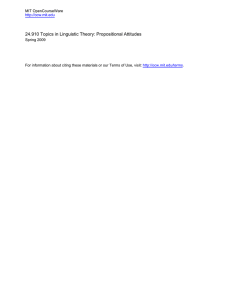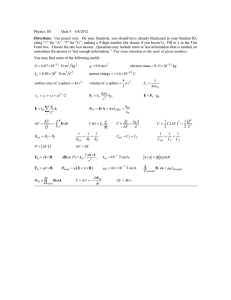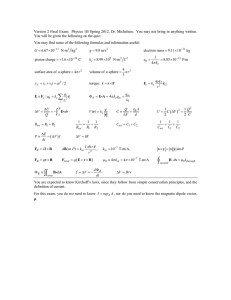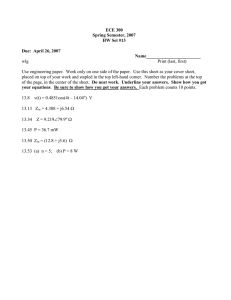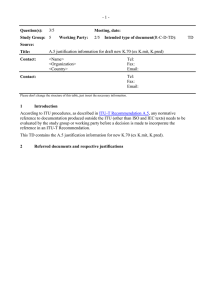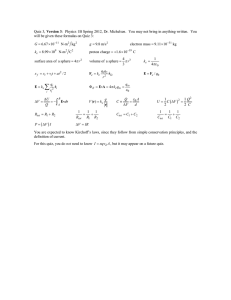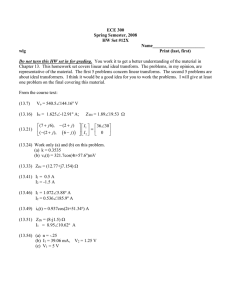EFFECT OF BRONCHODILATION ON EXPIRATORY FLOW-LIMITATION AND Online Data Supplement
advertisement
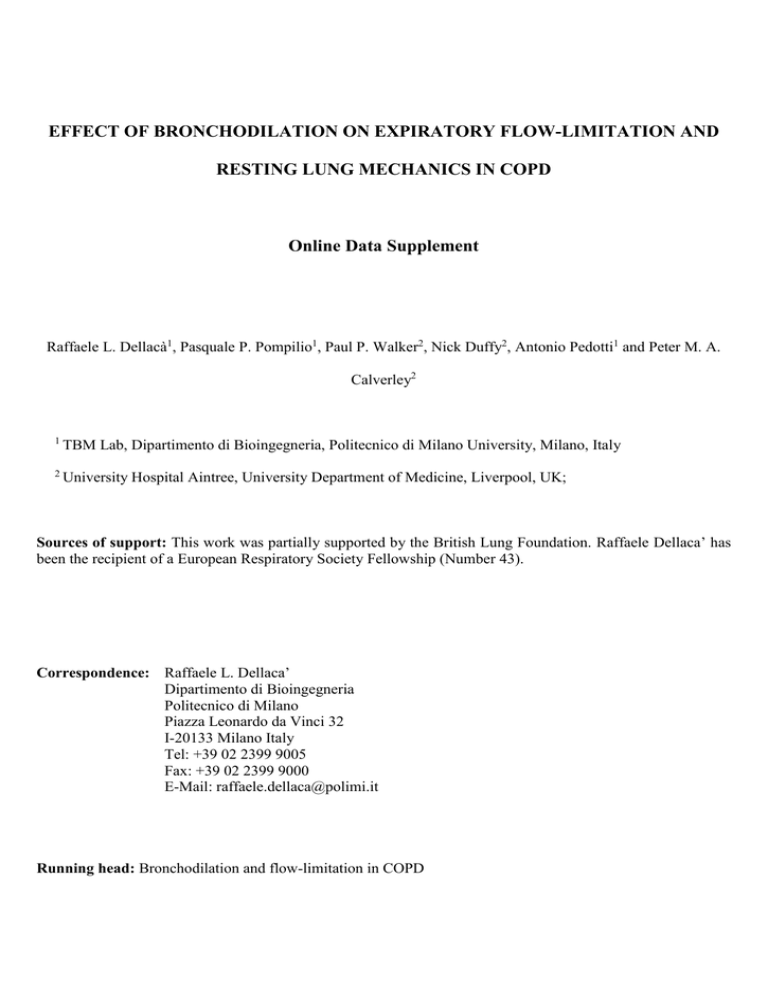
EFFECT OF BRONCHODILATION ON EXPIRATORY FLOW-LIMITATION AND RESTING LUNG MECHANICS IN COPD Online Data Supplement Raffaele L. Dellacà1, Pasquale P. Pompilio1, Paul P. Walker2, Nick Duffy2, Antonio Pedotti1 and Peter M. A. Calverley2 1 TBM Lab, Dipartimento di Bioingegneria, Politecnico di Milano University, Milano, Italy 2 University Hospital Aintree, University Department of Medicine, Liverpool, UK; Sources of support: This work was partially supported by the British Lung Foundation. Raffaele Dellaca’ has been the recipient of a European Respiratory Society Fellowship (Number 43). Correspondence: Raffaele L. Dellaca’ Dipartimento di Bioingegneria Politecnico di Milano Piazza Leonardo da Vinci 32 I-20133 Milano Italy Tel: +39 02 2399 9005 Fax: +39 02 2399 9000 E-Mail: raffaele.dellaca@polimi.it Running head: Bronchodilation and flow-limitation in COPD Comparison between single frequency and multifrequency forcing We have used the forced oscillation method to identify the presence of expiratory flow limitation on a breath by breath basis and to extend our observations to consider the effect of bronchodilators on the heterogeneity of lung obstruction in COPD by using a within-breath multifrquency PRN method. The measurements of Zin by FOT is usually carried on by either multifrequency signals or single sinusoidal signals. The first approach is usually applied by recording data for several breaths and by estimating the average mechanical response of the respiratory system at several frequencies(1). Conversely, single frequency signals have been used for estimating the within-breath variation of Zin(2;3). These two approaches provide complementary information: multifrequency signals allow the evaluation of the heterogeneity of the obstruction by providing the frequency dependence of Rrs and Xrs(4;5), while the single frequency signal provides information on the presence and degree of EFL (6). In principle, however, the two approaches are not mutually exclusive and, therefore, we developed and validated an approach for measuring within-breath multifrequency Zin. In order to provide a good signal-tonoise ratio we limited the number of frequencies of our forcing signal to three and we choose these frequencies to reduce the effects of non-linearities. To our knowledge there are no studies reporting the use of multifrequency signals for the estimation of within-breath Zin in humans. To validate the use of multifrequency forcing signal in detecting EFL we compared the values of Xrs at baseline measured by using the single sinusoidal forcing with the ones computed from the 5Hz component of the multyfrequency signal. On average, the difference between single frequency and multifrequency was 0.14±1.31 cmH2O*s/L, suggesting the absence of a systematic difference (bias) in the Xrs computed by the two different forcing waveforms. The average of the absolute value of the difference between the two measurements, which represent the average ‘distance’ between the measurements, was 0.84±1.00 cmH2O*s/L. The linear regression analysis provided a slope of 0.93 and as r² of 0.92 (Figure E1). All these results suggest a substantial agreement between the two measurements. On 42 patients, only 5 would be classified as FL or NFL differently by the Xrs computed by the two waveforms (3 would be FL with the single frequency forcing and NFL by the PRN). In 4 of these 5 patients we found that there were breaths classified differently (i.e. some FL and some NFL) in the same recording, suggesting that these patients were changing breath-by-breath their condition between FL and NFL for physiological rather than methodological reasons and, therefore, were borderline between FL and NFL. Considering that the measurements were not simultaneous and that there is a natural variability in patient’s condition, as we previously observed(7), these results confirm that the single frequency and the multifrequency within-breath methods provide substantially the same results, as theoretically expected. Concerning the other Zin parameters at 5Hz, we found that the use of our within-breath multi-frequency analysis produced very comparable results to that obtained when patients were tested with a single sinusoidal waveform (Table E1). For this reason, all the results reported in our study considered the data measured with the multifrequency signal only. We found only a slightly grater difference for both Zin parameters measured during expiration and the ones measured throughout all the breathing cycle when only EFL patients were considered (Table E1), in agreement with the hypothesis that the high nonlinearity of flow-limitation may affect the measurement of Zin. References (1) Michaelson ED, Grassman ED, Peters WR. Pulmonary mechanics by spectral analysis of forced random noise. J Clin Invest 1975 Nov;56(5):1210-30. (2) Horowitz JG, Siegel SD, Primiano FP, Jr., Chester EH. Computation of respiratory impedance from forced sinusoidal oscillations during breathing. Comput Biomed Res 1983 Dec;16(6):499-521. (3) Peslin R, Ying Y, Gallina C, Duvivier C. Within-breath variations of forced oscillation resistance in healthy subjects. Eur Respir J 1992;5(1):86-92. (4) Lutchen KR, Greenstein JL, Suki B. How inhomogeneities and airway walls affect frequency dependence and separation of airway and tissue properties. J Appl Physiol 1996;80(5):1696-707. (5) Otis AB, Mc Kerrow CB, Bartlett RA, Mead J, McIlroy MB, Selverstone NJ, et al. Mechanical factors in distribution of pulmonary ventilation. J Appl Physiol 1956;8:427-43. (6) Dellaca RL, Santus P, Aliverti A, Stevenson N, Centanni S, Macklem PT, et al. Detection of expiratory flow limitation in COPD using the forced oscillation technique. Eur Respir J 2004 Feb;23(2):232-40. (7) Dellaca RL, Duffy N, Pompilio PP, Aliverti A, Koulouris NG, Pedotti A, et al. Expiratory flow limitation detected by forced oscillation and negative expiratory pressure. Eur Respir J 2007 Feb;29(2):363-74. Table E1: Comparison between impedance indices computed during the application of single frequency (sf) and multifrequency (mf) forcing signals. sf Mean All subjects mf STD Mean mf-sf STD p Mean STD abs(mf-sf) Mean STD Xinsp -2.293 ± 1.234 -2.330 ± 1.162 0.693 -0.037 ± 0.603 0.439 ± 0.410 Xexp -5.347 ± 4.273 -5.273 ± 4.275 0.757 0.074 ± 1.548 1.022 ± 1.153 Xtot Xrs -4.279 ± 3.274 -4.264 ± 3.281 0.933 0.015 ± 1.124 0.734 ± 0.843 3.054 ± 3.513 2.943 ± 3.411 0.586 -0.111 ± 1.316 0.837 ± 1.013 Rinsp 5.173 ± 1.772 5.054 ± 1.645 0.287 -0.119 ± 0.713 0.532 ± 0.482 Rexp 6.719 ± 3.128 6.181 ± 2.461 0.003 -0.538 ± 1.094 0.977 ± 0.718 Rtot 6.146 ± 2.606 5.774 ± 2.120 0.011 -0.372 ± 0.902 0.780 ± 0.577 Xinsp -1.679 ± 0.968 -1.663 ± 0.914 0.884 0.016 ± 0.505 0.352 ± 0.353 Xexp -2.469 ± 1.963 -2.085 ± 1.449 0.046 0.384 ± 0.851 0.684 ± 0.623 Xtot Xrs -2.151 ± 1.558 -1.914 ± 1.220 0.116 0.238 ± 0.680 0.516 ± 0.492 0.790 ± 1.189 0.422 ± 0.730 0.008 -0.368 ± 0.588 0.465 ± 0.511 Rinsp 4.479 ± 1.419 4.394 ± 1.242 0.512 -0.086 ± 0.603 0.425 ± 0.427 Rexp 5.747 ± 1.970 5.435 ± 1.533 0.125 -0.311 ± 0.915 0.809 ± 0.504 Rtot 5.213 ± 1.705 5.013 ± 1.377 0.224 -0.200 ± 0.749 0.624 ± 0.441 Xinsp -2.969 ± 1.155 -3.064 ± 0.953 0.553 -0.095 ± 0.704 0.534 ± 0.454 Xexp -8.513 ± 3.872 -8.779 ± 3.522 0.565 -0.266 ± 2.033 1.395 ± 1.470 Xtot Xrs -6.619 ± 3.072 -6.849 ± 2.855 0.485 -0.231 ± 1.446 0.974 ± 1.072 5.545 ± 3.551 5.716 ± 3.010 0.674 0.171 ± 1.787 1.247 ± 1.260 Rinsp 5.935 ± 1.839 5.781 ± 1.754 0.416 -0.155 ± 0.832 0.650 ± 0.522 Rexp 7.788 ± 3.811 7.002 ± 3.020 0.010 -0.786 ± 1.238 1.162 ± 0.874 Rtot 7.172 ± 3.053 6.610 ± 2.489 0.025 -0.562 ± 1.031 0.951 ± 0.666 Non Flow-Limited Flow Limited Table E2: Breathing pattern and within-breath input impedance measured at 5, 11 and 19Hz data for patients before (Pre) and after (Post) bronchodilation (BD). Impedance data are expressed as cmH2O*s/L. 11 Hz 19 Hz Post BD Mean ± SD 11.04 ± 3.46 12.05 ± 3.73 < 0.001 p Ve L/min Vt L 0.66 ± 0.24 0.71 ± 0.24 0.014 RR B/min 18.1 ± 5.6 18.1 ± 5.4 0.936 Ti s 1.37 ± 0.47 1.37 ± 0.54 0.975 Tot s 3.75 ± 1.53 3.74 ± 1.63 0.968 0.38 ± 0.06 0.37 ± 0.05 0.723 Ti/Ttot 5 Hz Pre BD Mean ± SD Vt/Ti L/s 0.50 ± 0.17 0.54 ± 0.17 < 0.001 Vt/Te L/s 0.30 ± 0.09 0.33 ± 0.11 0.001 Rinsp 5.1 ± 1.6 4.2 ± 1.5 < 0.001 Rexp 6.2 ± 2.5 5.8 ± 2.7 0.036 Rtot 5.8 ± 2.1 5.2 ± 2.2 0.001 Xinsp -2.3 ± 1.2 -1.8 ± 1.1 < 0.001 Xexp -5.3 ± 4.3 -3.8 ± 3.3 0.001 Xtot -4.3 ± 3.3 -3.1 ± 2.5 0.001 Xrs 2.9 ± 3.4 2.0 ± 2.5 0.004 R5 R19 1.8 ± 1.0 1.2 ± 0.9 < 0.001 Rinsp 4.0 ± 1.3 3.5 ± 1.1 < 0.001 Rexp 4.5 ± 1.6 4.4 ± 1.5 0.385 Rtot 4.3 ± 1.4 4.1 ± 1.3 0.025 Xinsp -1.5 ± 1.0 -1.0 ± 0.9 < 0.001 Xexp -3.0 ± 2.2 -2.2 ± 1.8 < 0.001 Xtot -2.5 ± 1.8 -1.8 ± 1.5 < 0.001 Rinsp 3.2 ± 1.0 3.0 ± 0.9 0.002 Rexp 3.7 ± 1.2 3.6 ± 1.2 0.429 Rtot 3.5 ± 1.1 3.4 ± 1.1 0.085 Xinsp -0.5 ± 0.7 0.0 ± 0.6 < 0.001 Xexp -1.3 ± 1.1 -0.8 ± 1.0 < 0.001 Xtot -1.0 ± 1.0 -0.5 ± 0.9 < 0.001 Table E3: Lung function, breathing pattern and impedance data at 5, 11 and 19Hz for patients who were not flow-limited at baseline (NFL) and patients who were (FL). For each group, data are reported before (Pre) and after (Post) bronchodilation (BD). The p values are reported for the paired comparison pre and post BD in each group and for the unpaired comparison between NFL and FL at baseline (NFL vs. FL column). Impedance data are expressed as cmH2O*s/L. Non flow-limited at baseline Pre BD Post BD Mean ± SD Mean ± SD FEV1 FEV1/FVC FVC SVC p p 1.47 ± 0.53 < 0.001 0.95 ± 0.27 1.14 ± 0.30 < 0.001 0.007 %pred 47.89 ± 14.55 54.72 ± 17.34 < 0.001 36.10 ± 10.07 43.15 ± 11.89 < 0.001 0.004 % 50.27 ± 10.59 50.36 ± 11.52 0.504 43.00 ± 9.81 41.90 ± 10.24 0.380 0.027 (L) 2.54 ± 0.70 2.91 ± 0.77 < 0.001 2.28 ± 0.65 2.80 ± 0.77 < 0.001 0.213 73.22 ± 14.64 83.26 ± 13.86 < 0.001 63.70 ± 12.32 78.60 ± 16.38 < 0.001 0.029 2.61 ± 0.72 2.90 ± 0.83 < 0.001 2.59 ± 0.70 2.99 ± 0.84 < 0.001 0.943 74.47 ± 13.56 82.77 ± 16.16 < 0.001 71.40 ± 11.68 82.80 ± 16.94 < 0.001 0.439 1.85 ± 0.53 2.01 ± 0.66 < 0.001 1.86 ± 0.53 2.18 ± 0.59 < 0.001 0.969 75.72 ± 18.47 81.04 ± 19.28 < 0.001 69.90 ± 17.28 82.00 ± 19.02 < 0.001 0.299 4.29 ± 1.21 4.02 ± 0.98 < 0.001 5.40 ± 1.18 5.04 ± 1.10 0.020 0.004 216.81 ± 57.88 203.69 ± 46.28 < 0.001 255.00 ± 54.92 238.11 ± 50.72 0.015 0.035 5.16 ± 1.33 4.93 ± 1.24 < 0.001 6.14 ± 1.49 5.84 ± 1.39 0.019 0.030 172.53 ± 33.05 164.73 ± 31.44 < 0.001 197.65 ± 35.64 188.28 ± 33.75 0.019 0.023 %pred (L) %pred (L) IC %pred (L) RV %pred TGV (L) %pred (L) TLC %pred IC/TLC% 19 Hz 6.97 ± 1.61 0.261 7.99 ± 1.67 7.97 ± 1.57 0.747 0.070 124.48 ± 17.33 0.184 138.65 ± 18.38 137.94 ± 15.73 0.703 0.031 26.7 ± 5.9 29.3 ± 7.1 0.001 24.5 ± 6.9 29.2 ± 7.5 < 0.001 0.284 L/min 9.94 ± 2.96 11.26 ± 3.21 < 0.001 12.24 ± 3.65 12.93 ± 4.14 0.112 0.030 Vt L 0.58 ± 0.24 0.64 ± 0.22 0.088 0.74 ± 0.21 0.79 ± 0.26 0.080 0.038 RR B/min 18.6 ± 6.5 18.8 ± 6.2 0.775 17.4 ± 4.6 17.3 ± 4.4 0.847 0.496 Ti s 1.45 ± 0.56 1.47 ± 0.66 0.881 1.29 ± 0.34 1.27 ± 0.37 0.673 0.273 Tot s 3.76 ± 1.85 3.77 ± 2.09 0.962 3.74 ± 1.11 3.72 ± 0.96 0.895 0.968 0.40 ± 0.05 0.40 ± 0.04 0.684 0.35 ± 0.05 0.35 ± 0.06 0.269 0.010 Vt/Ti L/s 0.42 ± 0.13 0.47 ± 0.12 0.010 0.59 ± 0.17 0.63 ± 0.17 0.005 0.001 Vt/Te L/s 0.28 ± 0.09 0.32 ± 0.10 < 0.001 0.32 ± 0.10 0.34 ± 0.12 0.239 0.157 Rinsp 4.4 ± 1.2 3.8 ± 1.5 0.014 5.8 ± 1.8 4.6 ± 1.3 < 0.001 0.005 Rexp 5.4 ± 1.5 4.9 ± 1.6 0.032 7.0 ± 3.0 6.9 ± 3.3 0.511 0.038 Rtot 5.0 ± 1.4 4.5 ± 1.5 0.024 6.6 ± 2.5 6.1 ± 2.6 0.020 0.013 Xinsp -1.7 ± 0.9 -1.5 ± 1.1 0.318 -3.1 ± 1.0 -2.2 ± 1.1 < 0.001 < 0.001 Xexp -2.1 ± 1.4 -2.0 ± 1.7 0.601 -8.8 ± 3.5 -5.8 ± 3.4 < 0.001 < 0.001 Xtot Xrs -1.9 ± 1.2 -1.8 ± 1.5 0.527 -6.8 ± 2.9 -4.6 ± 2.6 < 0.001 < 0.001 0.4 ± 0.7 0.4 ± 0.8 0.860 5.7 ± 3.0 3.7 ± 2.7 0.002 < 0.001 R5 R19 1.2 ± 0.7 0.8 ± 0.9 0.019 2.5 ± 0.7 1.6 ± 0.6 < 0.001 < 0.001 0.026 4.3 ± 1.6 3.6 ± 1.1 < 0.001 0.207 4.2 ± 1.1 0.063 4.5 ± 2.0 4.6 ± 1.9 0.281 0.978 Rtot 4.2 ± 1.1 3.8 ± 1.1 0.042 4.4 ± 1.8 4.3 ± 1.6 0.336 0.606 Xinsp -1.0 ± 0.7 -0.6 ± 1.0 0.048 -2.2 ± 0.8 -1.3 ± 0.7 < 0.001 < 0.001 Xexp -1.5 ± 0.9 -1.2 ± 1.1 0.105 -4.7 ± 1.9 -3.3 ± 1.8 < 0.001 < 0.001 Xtot -1.3 ± 0.8 -1.0 ± 1.1 0.085 -3.9 ± 1.5 -2.7 ± 1.4 < 0.001 < 0.001 Rinsp 3.2 ± 0.8 3.0 ± 0.9 0.085 3.3 ± 1.2 3.0 ± 1.0 0.006 0.852 Rexp 3.7 ± 0.9 3.6 ± 0.8 0.189 3.6 ± 1.4 3.7 ± 1.5 0.798 0.850 Rtot 3.5 ± 0.8 3.3 ± 0.8 0.121 3.5 ± 1.3 3.4 ± 1.3 0.440 0.998 s 3.4 ± 1.1 4.5 ± 1.2 r 3.8 ± 1.0 X Rinsp Rexp 11 Hz 7.02 ± 1.66 125.46 ± 19.76 Ve Ti/Ttot 5 Hz NFL vs. FL 1.27 ± 0.43 (L) p Flow-limited at baseline Pre BD Post BD Mean ± SD Mean ± SD Xinsp -0.2 ± 0.5 0.2 ± 0.6 0.007 -0.9 ± 0.6 -0.3 ± 0.4 < 0.001 < 0.001 Xexp -0.6 ± 0.6 -0.3 ± 0.8 0.024 -2.0 ± 1.1 -1.3 ± 1.0 < 0.001 < 0.001 Xtot -0.4 ± 0.6 -0.1 ± 0.7 0.015 -1.6 ± 1.0 -1.0 ± 0.8 < 0.001 < 0.001 Table E4: Spirometric data, lung volumes, breathing pattern and Zrs data for responder and non responder patients to brocnhodilation. The p values are reported for the paired comparison pre and post BD in each group and for the unpaired comparison between non responders (NR) and responders (R) (NR vs. R column). Pre BD Mean ± SD FEV1 FEV1/FVC FVC SVC (L) %pred Hz 1.20 ± 0.39 1.55 ± 0.45 <0.001 NS 43.51 ± 11.80 56.23 ± 13.83 <0.001 NS NS 0.47 ± 0.09 0.48 ± 0.11 NS NS (L) 2.32 ± 0.68 2.60 ± 0.12 <0.001 2.56 ± 0.69 3.29 ± 0.69 <0.001 NS 67.70 ± 16.45 74.88 ± 14.55 <0.001 70.07 ± 11.49 91.80 ± 13.74 <0.001 NS 2.59 ± 0.78 2.71 ± 0.77 NS 2.72 ± 0.68 3.31 ± 0.89 <0.001 NS 74.52 ± 14.14 77.76 ± 13.98 0.050 73.38 ± 12.80 89.17 ± 18.83 <0.001 NS 1.80 ± 0.51 1.97 ± 0.56 0.001 1.94 ± 0.57 2.26 ± 0.66 <0.001 NS 72.17 ± 16.87 79.52 ± 17.46 0.080 74.40 ± 20.22 84.95 ± 19.58 <0.001 NS 4.52 ± 1.35 4.45 ± 1.14 NS 4.76 ± 1.13 4.06 ± 0.92 <0.001 NS 223.74 ± 60.60 222.17 ± 47.55 NS 228.23 ± 54.49 189.48 ± 44.44 <0.001 NS 5.31 ± 1.61 5.10 ± 1.37 0.042 5.59 ± 1.18 5.11 ± 0.92 <0.001 NS 179.41 ± 39.17 171.86 ± 31.37 0.027 178.60 ± 30.12 162.85 ± 32.70 <0.001 NS 7.09 ± 1.82 7.10 ± 1.66 NS 7.52 ± 1.42 7.34 ± 1.37 NS NS 129.84 ± 18.12 129.07 ± 13.12 NS 127.60 ± 20.40 124.97 ± 19.41 0.086 NS 25.4 ± 6.6 28.1 ± 6.8 0.001 26.0 ± 6.2 30.7 ± 7.6 <0.001 NS 10.10 ± 3.32 10.91 ± 3.13 0.021 12.28 ± 3.34 13.58 ± 4.00 0.005 NS %pred (L) %pred (L) %pred (L) %pred Ve L/min Vt L 0.64 ± 0.24 0.71 ± 0.27 0.037 0.67 ± 0.24 0.71 ± 0.22 NS NS RR B/min 16.9 ± 5.3 16.7 ± 5.1 NS 19.6 ± 5.7 20.0 ± 5.4 NS NS Ti s 1.40 ± 0.44 1.47 ± 0.65 NS 1.34 ± 0.53 1.24 ± 0.31 NS NS Tot s 4.03 ± 1.76 4.12 ± 1.97 NS 3.37 ± 1.08 3.24 ± 0.85 NS NS 0.36 ± 0.06 0.36 ± 0.06 NS 0.39 ± 0.05 0.39 ± 0.04 NS NS Vt/Ti L/s 0.48 ± 0.16 0.51 ± 0.15 0.006 0.53 ± 0.18 0.59 ± 0.19 0.009 NS Vt/Te L/s 0.27 ± 0.09 0.29 ± 0.09 0.037 0.34 ± 0.08 0.38 ± 0.11 0.013 NS Rinsp 4.9 ± 1.8 4.4 ± 1.5 0.007 5.3 ± 1.5 3.9 ± 1.3 <0.001 NS Rexp 6.4 ± 3.2 6.4 ± 3.3 NS 5.9 ± 1.0 5.1 ± 1.4 0.007 NS Rtot 5.8 ± 2.7 5.7 ± 2.7 NS 5.7 ± 1.1 4.7 ± 1.3 0.001 NS Xinsp -2.2 ± 1.2 -1.9 ± 1.1 NS -2.5 ± 1.1 -1.7 ± 1.2 <0.001 NS Xexp -5.3 ± 4.9 -4.3 ± 3.8 NS -5.2 ± 3.3 -3.1 ± 2.4 <0.001 NS Xtot Xrs -4.3 ± 3.8 -3.5 ± 2.8 NS -4.2 ± 2.4 -2.6 ± 1.9 <0.001 NS 3.1 ± 4.0 2.4 ± 3.0 NS 2.7 ± 2.6 1.4 ± 1.5 0.001 NS R5 R19 1.6 ± 0.9 1.2 ± 0.8 0.011 2.1 ± 1.0 1.1 ± 1.0 <0.001 NS NS 4.0 ± 0.9 3.2 ± 0.7 <0.001 NS 4.7 ± 1.9 NS 4.2 ± 0.8 4.0 ± 0.8 NS NS Rtot 4.4 ± 1.8 4.4 ± 1.6 NS 4.1 ± 0.7 3.7 ± 0.7 0.014 NS Xinsp -1.3 ± 0.9 -1.0 ± 0.8 0.013 -2.5 ± 1.1 -0.9 ± 1.0 <0.001 NS Xexp -3.0 ± 2.5 -2.5 ± 1.7 NS -5.2 ± 3.3 -1.8 ± 1.4 <0.001 NS Xtot -2.5 ± 2.1 -2.0 ± 1.7 0.047 -4.2 ± 2.4 -1.5 ± 1.2 <0.001 NS Rinsp 3.3 ± 1.2 3.2 ± 1.1 NS 3.2 ± 0.7 2.7 ± 0.5 <0.001 NS Rexp 3.8 ± 1.4 3.8 ± 1.4 NS 3.5 ± 0.6 3.3 ± 0.6 NS NS Rtot 3.6 ± 1.3 3.6 ± 1.3 NS 3.4 ± 0.5 3.1 ± 0.5 0.031 NS Xinsp -0.4 ± 0.7 -0.1 ± 0.6 0.004 -0.8 ± 0.6 0.0 ± 0.6 <0.001 NS Xexp -1.3 ± 1.4 -0.9 ± 1.1 0.039 -1.3 ± 0.8 -0.5 ± 0.8 <0.001 NS Xtot -1.0 ± 1.2 -0.7 ± 1.0 0.021 -1.1 ± 0.7 -0.3 ± 0.7 <0.001 NS s 3.8 ± 1.2 4.7 ± 2.0 r 4.0 ± 1.5 X Rinsp Rexp 19 NS <0.001 Ti/Ttot 11 Hz p 1.15 ± 0.40 0.45 ± 0.12 IC/TLC% 5 Hz p 1.06 ± 0.39 44.19 ± 15.92 %pred TLC NR vs. R 0.46 ± 0.11 (L) TGV Responders Post BD Mean ± SD 40.93 ± 15.15 %pred RV p Pre BD Mean ± SD % (L) IC Not responders Post BD Mean ± SD Figure E1: Linear regression analysis of Xrs measured at 5Hz during single frequency (SF) and multifrequency (MF) forcing. 16 14 Xrs MF (cmH2O*s/L) 12 10 8 6 4 2 0 -2 -2 0 2 4 6 8 10 Xrs SF (cmH2O*s/L) 12 14 16 18
